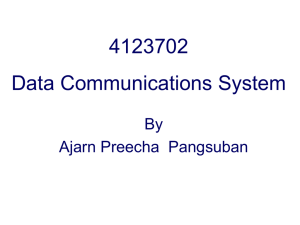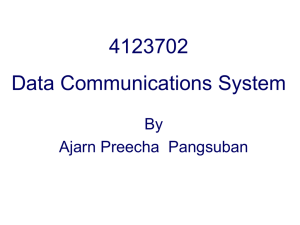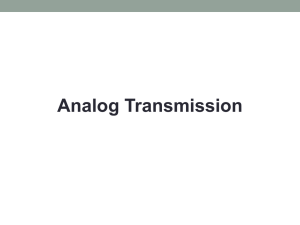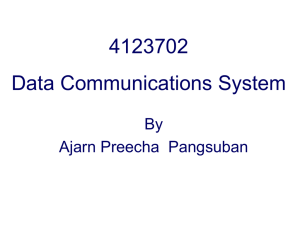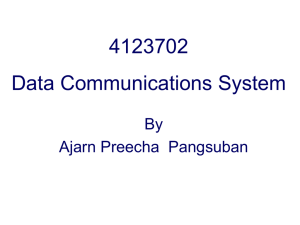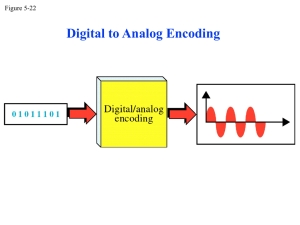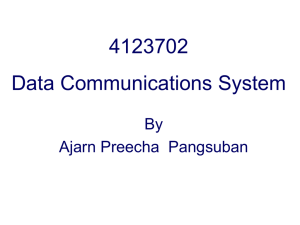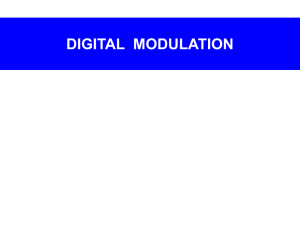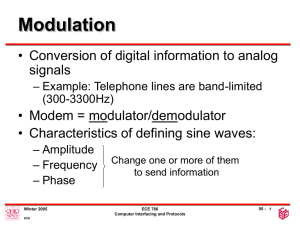ch5-Analog Transmiss..
advertisement
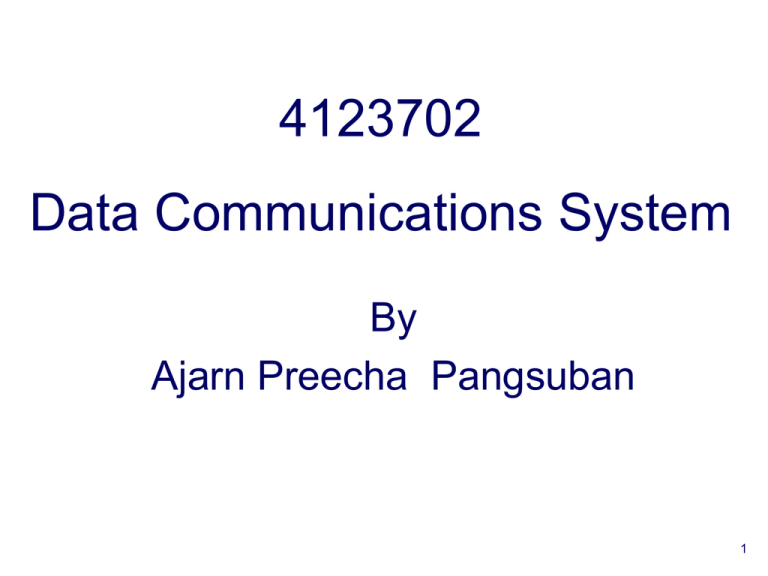
4123702 Data Communications System By Ajarn Preecha Pangsuban 1 Chapter 5 – Analog Transmission 2 Analog Signals Infinite number of values in a range More susceptible to noise and is less precise than a digital signal Since they are more variable than digital signals, they can convey greater subtleties 4123702 Data Communications System @YRU 3 Bit Rate and Baud Rate Bit rate – number of bits transmitted in 1 second Computer efficiency Baud rate – number of signal units per second required to represent those bits; equal to or less than bit rate Network transmission efficiency Determines bandwidth required 4123702 Data Communications System @YRU 4 Example 1 An analog signal carries 4 bits in each signal unit. If 1000 signal units are sent per second, find the baud rate and the bit rate. Solution Baud rate = 1000 bauds per second (baud/s) Bit rate = 1000 x 4 = 4000 bps 4123702 Data Communications System @YRU 5 Example 2 The bit rate of a signal is 3000. If each signal unit carries 6 bits, what is the baud rate? Solution Baud rate = bit rate/bits per signal = 3000 / 6 = 500 baud/s 4123702 Data Communications System @YRU 6 Modulation of Digital Data Carrier Signal - High-frequency signal used for digital-to-analog or analog-to-digital modulation May change any aspect of an analog signal to represent digital data: amplitude, frequency, and phase Modulation - process of changing one of the characteristics of an analog signals based on information in digital signal 4123702 Data Communications System @YRU 7 Digital-to-Analog Conversion 4123702 Data Communications System @YRU 8 Methods Three mechanisms Amplitude shift keying (ASK) Frequency shift keying (FSK) Phase shift keying (PSK) Combined approach: quadrature amplitude modulation (QAM) 4123702 Data Communications System @YRU 9 Amplitude Shift Keying (ASK) Strength of carrier signal is varied to represent a 1 or 0 Frequency and phase remain constant while amplitude is changed Amplitude remains constant during bit duration Highly susceptible to noise interference since noise usually affects amplitude Minimum bandwidth required is equal to baud rate 4123702 Data Communications System @YRU 10 Amplitude Shift Keying (ASK) 4123702 Data Communications System @YRU 11 Relationship between baud rate and bandwidth in ASK BW = (1+d)Nbaud 4123702 Data Communications System @YRU 12 Example 3 Find the minimum bandwidth for an ASK signal transmitting at 2000 bps. The transmission mode is halfduplex. Solution In ASK the baud rate and bit rate are the same. The baud rate is therefore 2000. An ASK signal requires a minimum bandwidth equal to its baud rate. Therefore, the minimum bandwidth is 2000 Hz. 4123702 Data Communications System @YRU 13 Example 4 Given a bandwidth of 5000 Hz for an ASK signal, what are the baud rate and bit rate? Solution In ASK the baud rate is the same as the bandwidth, which means the baud rate is 5000. But because the baud rate and the bit rate are also the same for ASK, the bit rate is 5000 bps. 4123702 Data Communications System @YRU 14 Example 5 Given a bandwidth of 10,000 Hz (1000 to 11,000 Hz), draw the full-duplex ASK diagram of the system. Find the carriers and the bandwidths in each direction. Assume there is no gap between the bands in the two directions. Solution For full-duplex ASK, the bandwidth for each direction is BW = 10000 / 2 = 5000 Hz The carrier frequencies can be chosen at the middle of each band (see Fig. 5.5). fc (forward) = 1000 + 5000/2 = 3500 Hz fc (backward) = 11000 – 5000/2 = 8500 Hz 4123702 Data Communications System @YRU 15 Solution to Example 5 4123702 Data Communications System @YRU 16 Frequency Shift Keying (FSK) Frequency is varied to represent a 1 or 0 Frequency during bit duration is constant Amplitude and phase remain constant Avoids most of noise problems of ASK; can ignore voltage spikes Limited by physical capabilities of medium Bandwidth required is equal to baud rate plus frequency shift 4123702 Data Communications System @YRU 17 Frequency Shift Keying (FSK) 4123702 Data Communications System @YRU 18 Relationship between baud rate and bandwidth in FSK BW = fc1-fc0+Nbaud 4123702 Data Communications System @YRU 19 Example 6 Find the minimum bandwidth for an FSK signal transmitting at 2000 bps. Transmission is in half-duplex mode, and the carriers are separated by 3000 Hz. Solution For FSK BW = baud rate + fc1 - fc0 BW = bit rate + fc1 - fc0 = 2000 + 3000 = 5000 Hz 4123702 Data Communications System @YRU 20 Example 7 Find the maximum bit rates for an FSK signal if the bandwidth of the medium is 12,000 Hz and the difference between the two carriers is 2000 Hz. Transmission is in full-duplex mode. Solution Because the transmission is full duplex, only 6000 Hz is allocated for each direction. BW = baud rate + fc1 - fc0 Baud rate = BW - (fc1 - fc0 ) = 6000 - 2000 = 4000 But because the baud rate is the same as the bit rate, the bit rate is 4000 bps. 4123702 Data Communications System @YRU 21 Phase Shift Keying (PSK) Phase of carrier is varied to represent 1 or 0 Peak amplitude and frequency remain constant Phase remains constant during each bit duration Not as susceptible to noise degradation as ASK or to bandwidth limitations of FSK 4123702 Data Communications System @YRU 22 Phase Shift Keying (PSK) 2-PSK or Binary PSK 4123702 Data Communications System @YRU 23 PSK constellation (Phase state diagram) Constellation is a graphical representation of the phase and amplitude of different bit combinations in digital-toanalog modulation. 4123702 Data Communications System @YRU 24 4-PSK; 8-PSK 4-PSK May utilize four variations of phase shift by 90 degrees Each phase shift represents 2 bits (dibit); technique is referred to as 4-PSK Allows data transmission two times as fast as 2-PSK 8-PSK Vary signal by shifts of 45 degrees; each shift may then represent three bits (tribit) and send data three times as fast 4123702 Data Communications System @YRU 25 The 4-PSK method (Q-PSK) 4123702 Data Communications System @YRU 26 The 4-PSK characteristics 4123702 Data Communications System @YRU 27 The 8-PSK characteristics 4123702 Data Communications System @YRU 28 Relationship between baud rate and bandwidth in PSK BW = (1+d)Nbaud 4123702 Data Communications System @YRU 29 Example 8 Find the bandwidth for a 4-PSK signal transmitting at 2000 bps. Transmission is in half-duplex mode. Solution For 4-PSK the baud rate is one –half of the bit rate (1 baud : 2 bit). The baud rate is therefore 1000. A PSK signal requires a bandwidth equal to its baud rate . Therefore, the bandwidth is 1000 Hz 4123702 Data Communications System @YRU 30 Example 9 Given a bandwidth of 5000 Hz for an 8-PSK signal, what are the baud rate and bit rate? Solution For PSK the baud rate is the same as the bandwidth, which means the baud rate is 5000. But in 8-PSK the bit rate is 3 times the baud rate, so the bit rate is 15,000 bps. 4123702 Data Communications System @YRU 31 Quadrature Amplitude Modulation (QAM) Combination of ASK and PSK so that a maximum contrast between each signal unit (bit, dibit, tribit, and so on) is achieved x number of variations in phase and y variations in amplitude Number of phase shifts is always larger than number of amplitude shifts due to amplitude susceptibility to noise QAM is therefore less susceptible to noise than ASK Same bandwidth is required for ASK and PSK 4123702 Data Communications System @YRU 32 The 4-QAM and 8-QAM constellations 4123702 Data Communications System @YRU 33 Time domain for an 8-QAM signal 4123702 Data Communications System @YRU 34 16-QAM constellations 4123702 Data Communications System @YRU 35 Bit/Baud Comparison 4123702 Data Communications System @YRU 36 Bit and baud rate comparison Modulation Units Bits/Baud Baud rate Bit Rate ASK, FSK, 2-PSK Bit 1 N N 4-PSK, 4-QAM Dibit 2 N 2N 8-PSK, 8-QAM Tribit 3 N 3N 16-QAM Quadbit 4 N 4N 32-QAM Pentabit 5 N 5N 64-QAM Hexabit 6 N 6N 128-QAM Septabit 7 N 7N 256-QAM Octabit 8 N 8N 4123702 Data Communications System @YRU 37 Example 10 A constellation diagram consists of eight equally spaced points on a circle. If the bit rate is 4800 bps, what is the baud rate? Solution The constellation indicates 8-PSK with the points 45 degrees apart. Since 23 = 8, 3 bits are transmitted with each signal unit. Therefore, the baud rate is 4800/3 = 1600 baud 4123702 Data Communications System @YRU 38 Example 11 Compute the bit rate for a 1000-baud 16-QAM signal. Solution A 16-QAM signal has 4 bits per signal unit since log216 = 4. Thus, (1000)(4) = 4000 bps 4123702 Data Communications System @YRU 39 Example 12 Compute the baud rate for a 72,000-bps 64-QAM signal. Solution A 64-QAM signal has 6 bits per signal unit since log2 64 = 6. Thus, 72000/6 = 12,000 baud 4123702 Data Communications System @YRU 40 5.2 Telephone Modems Traditional phone lines carry frequencies between 300 and 3300 Hz; bandwidth of 3000 Hz All this range is used for transmitting voice Data signals require higher degree of accuracy to ensure integrity (the edges of this range are not used) Effective bandwidth for data transmission is 2400 Hz (between 600 and 3000 Hz) MODEM is a composite word refer to signal modulator and signal demodulator modulator – creates a band-pass analog signal from binary data demodulator – recovers binary data from modulated signal 4123702 Data Communications System @YRU 41 Telephone line bandwidth 4123702 Data Communications System @YRU 42 Modulation/demodulation Telco is Telephone Company or Your local telephone service provider (such as TOT, TT&T) 4123702 Data Communications System @YRU 43 Modem Standards The most popular MODEMs available are based on the V-series standards by the ITU-T V-series standards that define data transmission over telephone lines. (ITU-T : International Telecommunications UnionTelecommunication Standardization Sector) 4123702 Data Communications System @YRU 44 V.32 (32-QAM) A combined modulation and encoding technique called Trellis Coded Modulation (TCM) Trellis is essentially QAM plus a redundant bit A pentabit is transmitted (4 bit data stream and 1 extra bit ) 4123702 Data Communications System @YRU 45 The V.32 constellation and bandwidth 4123702 Data Communications System @YRU 46 V.32 bis (128-QAM) The first of the ITU-T standards to support 14,400 bps transmission Uses 128-QAM transmission (7 bit/baud with 1 bit for error control) Data rate of 2400 baud is 2400*6 = 14,400 bps Automatic speed adjustment depending on quality of line or signal 4123702 Data Communications System @YRU 47 The V.32bis constellation and bandwidth 4123702 Data Communications System @YRU 48 V.34 bis For bit rate of 28,800 with a 960 point constellation to a bit rate 33,600 with 1664 point constellation 4123702 Data Communications System @YRU 49 V.90 V.90 MODEM with a bit rate 56,00bps, called 56 k MODEMs The downloading rate is a maximum of 56kbps, while the uploading rate can be maximum of 33.6 kbps (asymmetric) These MODEM may be used only if one party is using digital signaling (such as through an ISP) 4123702 Data Communications System @YRU 50 Traditional modems (33.6kbps) 4123702 Data Communications System @YRU 51 56K modems 4123702 Data Communications System @YRU 52 V.92 These MODEM can adjust their speed , and if the noise allows, the can upload data at the rate of 48 kbps The downloading rate is a maximum of 56kbps The MODEM can interrupt the Internet connection when there is an incoming call if the line has callwaiting service 4123702 Data Communications System @YRU 53 MODEM type Asynchronous, Synchronous Low-speed modems are designed to operate asynchronously High-speed modems as well as leased-lines modems use synchonous tranmission Half-Duplex, Full-Duplex A half-duplex modem must alternately send and received signals Half-duplex A full-duplex modem can simultaneously handle two signals using two carriers to transmit and receive data 4123702 Data Communications System @YRU 54 5.3 Modulation of Analog Signals Analog to analog conversion is the presentation of analog information by an analog signal Example is radio Can accomplished in three ways : Amplitude Modulation (AM) Frequency Modulation (FM) Phase Modulation (PM) 4123702 Data Communications System @YRU 55 Analog-to-analog modulation 4123702 Data Communications System @YRU 56 Amplitude modulation (AM) Amplitude varies with changing amplitudes of the modulating signal Frequency and phase remain the same 4123702 Data Communications System @YRU 57 AM bandwidth Carrier frequency between 530 and 1700 kHz AM radio station needs a minimum BW of 10 kHz (By FCC) The total bandwidth required for AM can be determined from the bandwidth of the audio signal Equal to twice the bandwidth of the audio signal Carrier frequencies must be separated on either side to avoid interference Total bandwidth determined by: BWt = 2 * BWm 4123702 Data Communications System @YRU 58 AM bandwidth (cont) 4123702 Data Communications System @YRU 59 AM band allocation 4123702 Data Communications System @YRU 60 Example 13 We have an audio signal with a bandwidth of 4 KHz. What is the bandwidth needed if we modulate the signal using AM? Ignore FCC regulations. Solution An AM signal requires twice the bandwidth of the original signal: BW = 2 x 4 KHz = 8 KHz 4123702 Data Communications System @YRU 61 Frequency modulation (FM) Frequency of carrier signal is modulated to follow changing voltage level (amplitude) of the modulating signal Peak amplitude and phase remain constant 4123702 Data Communications System @YRU 62 FM bandwidth Carrier frequency between 88MHz and 108 MHz The bandwidth of a stereo audio signal is usually 15 KHz. Therefore, an FM station needs at least a bandwidth of 150 KHz. The FCC requires the minimum bandwidth to be at least 200 KHz (0.2 MHz). The total bandwidth required for FM can be determined from the bandwidth of the audio signal: BWt = 10 * BWm 4123702 Data Communications System @YRU 63 FM bandwidth (cont) 4123702 Data Communications System @YRU 64 FM band allocation 4123702 Data Communications System @YRU 65 Example 14 We have an audio signal with a bandwidth of 4 MHz. What is the bandwidth needed if we modulate the signal using FM? Ignore FCC regulations. Solution An FM signal requires 10 times the bandwidth of the original signal: BW = 10 x 4 MHz = 40 MHz 4123702 Data Communications System @YRU 66 Phase Modulation (PM) Sometimes used as an alternative to FM Simpler hardware requirements Phase is modulated to follow changing voltage level (amplitude) of modulating signal Peak amplitude and frequency remains constant The analysis and the final result are similar FM 4123702 Data Communications System @YRU 67 Credits All figures obtained from publisher-provided instructor downloads Data Communications and Networking, 3rd edition by Behrouz A. Forouzan. McGraw Hill Publishing, 2004 4123702 Data Communications System @YRU 68
